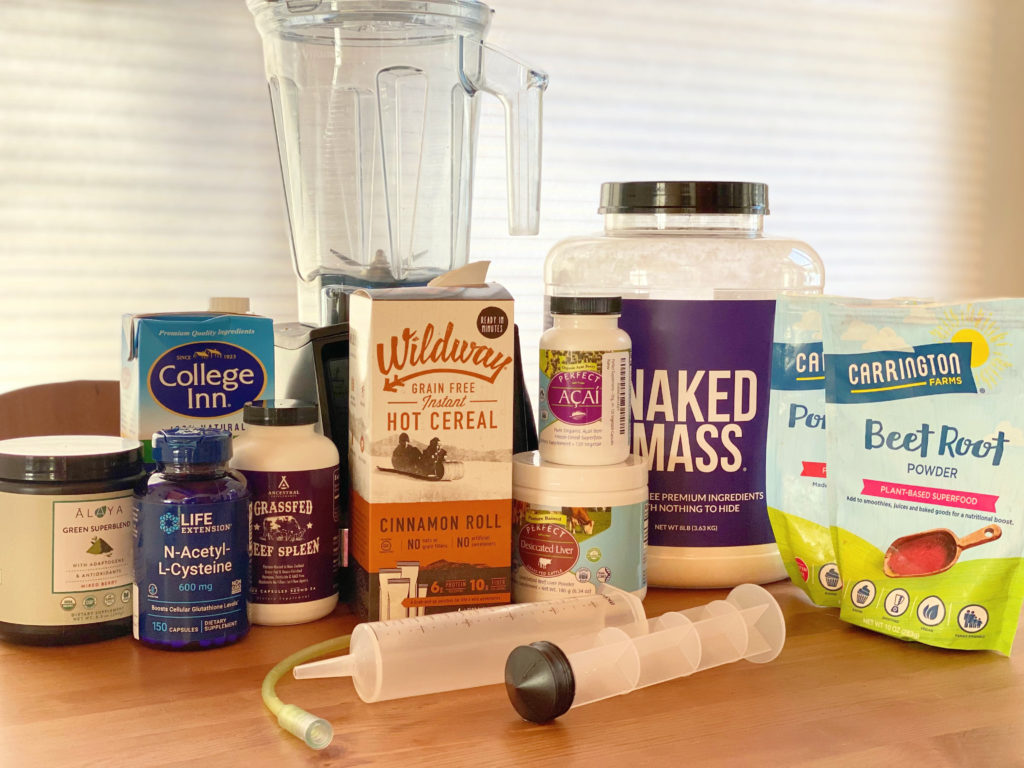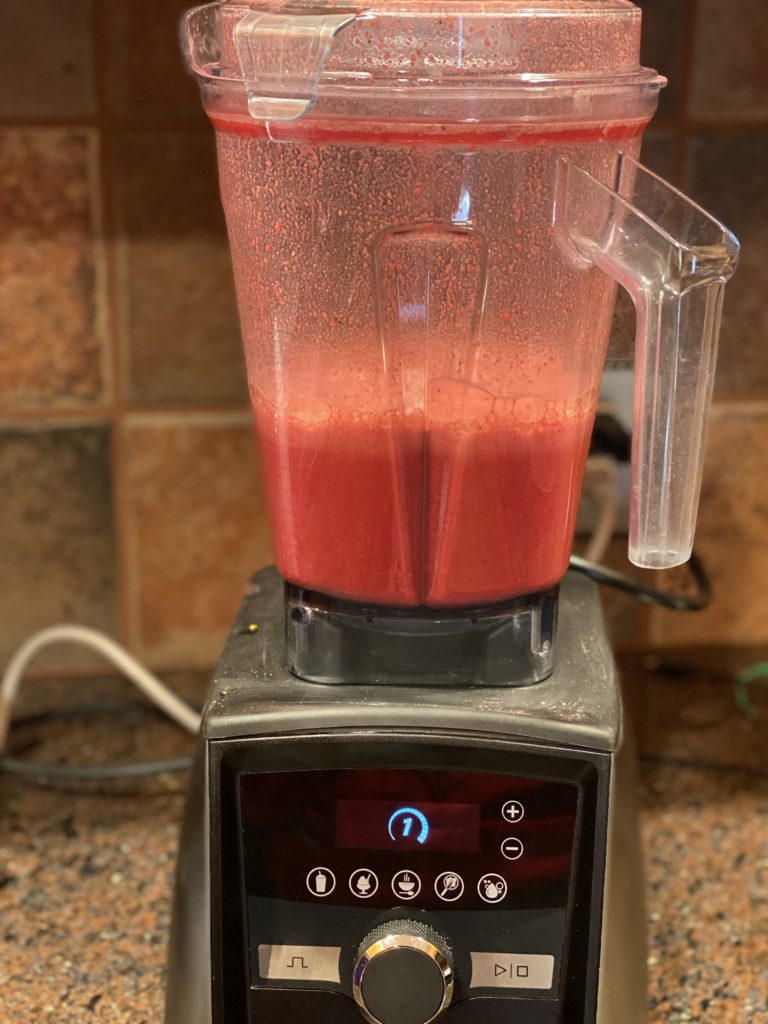Gunnar has asked me to write a blog with my feeding tube recipes for a few years now, but it never felt right to me. After all, I’m not a dietician or nutritionist, so who am I to suggest what people pour into their gullet?
But this week is feeding tube awareness week, and as I like to say, I love Gunnar’s feeding tube. Feeding people (and dogs) is definitely one of my love languages, and food has also been tremendously healing for me (I have celiac disease so I’m very conscious about what I eat).
All that aside, the reason I want to share one of my carefully crafted feeding tube recipes is because it has been working. Gunnar has been on Trikafta for almost 3 years (!!), and while it has been nothing short of a miracle, it hasn’t impacted his weight in the same significant way I’ve seen it affect others (he has gained a little under 10 lbs. over the last 2 ¾ years).
Gunnar has a g-tube and he uses it almost daily. He does a bolus feed of one of my shakes a couple times during the week, and he does an overnight feed with liquid hope almost every night. I’ve spent the last couple years wondering why he hasn’t gained the substantial Trikafta weight that others have gained. At 6’3, he’s very lean, which isn’t ideal for someone who’s favorite form of exercise is Men’s League Hockey.
In the fall, I started tracking Gunnar’s caloric intake (aren’t I so romantic!?). Gunnar has never been the best oral eater for a variety of CF-related reasons (antibiotics changing his sense of taste, feeling full really quickly, etc.). He’s also dreadfully picky, but whether that’s CF-related or just a juvenile idiosyncrasy, I’ll never know 🙂
My meticulous tracking led me to a critical hypothesis – his overnight feeds, which he relied on to get enough calories, might be doing more harm than good. The problem was that Gunnar would do an overnight feed, then wake up feeling full and skip breakfast. And then, because he’s so picky, he’d have a half-hearted lunch at around 1pm (eg. pick at a peanut butter sandwich on white bread, or eat a handful of pretzels, etc.). By dinner time he’d be very hungry, but since he naturally gets full so easily, he’d serve himself a plate with two hamburgers, mac n cheese, and carrots – but then only eat half of the plate. Put simply, he wasn’t getting nearly enough calories during the day (and of those calories, the nutrient density was quite low).
So I appealed to Gunnar’s competitive nature and offered him a challenge. At the beginning of January, I told him that I was going to (1) get him fat by the summer, and (2) get him a better night’s sleep. All he had to do was consume one of my shakes through his feeding tube every day, and drop his overnight feed. While it may have seemed ludicrous to drop the overnight feed, Gunnar trusted me enough to agree to my challenge (#marriage). And you know what…. Gunnar has steadily gained about a pound every week of this challenge.
The most obvious change is that Gunnar now gets more calories during the day, even though he’s getting zero calories at night. His sleep quality has also improved without the overnight feed, which we all know is critical for overall health. By committing to one, hyper-nutrient dense meal a day, I’d venture to guess that Gunnar is getting more consistent nutrition as well. He can go about eating his regular oral foods (which aren’t much more than lucky charms, mac n cheese, white bread, and red meat), while still meeting high nutritional standards.
I have a third hypothesis that has been laughed at by medical professionals and is unstudied, but I stand by it. Hear me out – the vast majority of people don’t eat in the middle of the night. We fast for 8-12 hours, every single day, while we sleep. But Gunnar, and other tube-fed people, are somehow expected to have their (already compromised) digestive systems work around the clock. “But Darcy, your digestive system, and all of your organ systems, still work while you sleep.” Yes, I understand that, but I can only imagine that I’d deal with increased GI distress and inflammation if I “ate” all day and all night. The research on tube feeding nutrition is stark enough as it is, so it’s not surprising there is nothing out there that looks at the long-term impact of 24/7 feeding. Isn’t there something to be said for “giving your intestines and metabolism a break,” if you will? Isn’t the human body designed to fast overnight? Aren’t hormones regulated when blood sugar drops (overnight)? Why aren’t there at least 100 studies that look at this?
*Sigh* But I digress… our new method of tube feeding has been working for Gunnar, so I’m happy. He’s gaining weight and sleeping through the night, so he’s happy. Below, I’m going to share the daily concoction that I make for Gunnar. It’s been altered over the years, as we’ve learned what works for him (a base that digests slowly) and what doesn’t work for him (adding oil, even though those calories/nutrition are good). Gunnar doesn’t like to spend much more than five minutes doing a feed, so his blends are very thin. He also has a psychological complex about blending food he orally eats, so I don’t blend things like meat or mac n cheese. I’m going to try my best to break down the nutrition facts of this recipe, but since there are little adjustments I make daily, it is likely going to be a smidge off!
Slow-digesting Macronutrient Base:
1 package of Wildway hot cereal
OR
1 cup of overnight oats
OR
2 fried eggs cooked in butter plus 2 tablespoons coconut flour
Extra Protein:
2 scoops whey protein powder (I will note that pre-Trikafta, I considered the fact that daily casein intake may lead to increased mucus production [out of an abundance of caution – the literature suggests it probably doesn’t]. We used a plant-based protein powder back then.)
Nutrient Dense Additions:
8g of a powdered greens superblend (I alternate brands so Gunnar gets more diverse greens. However, we avoid blends that contain slippery elm because it may slow the absorption of medications, and we avoid blends that contain milk thistle because it works on the liver and CFTR modulators may impact the liver [the connection between milk thistle and CFTR modulators is unstudied, this is purely a precaution I choose to take])
A liberal shake of beet root powder (Beetroot, which increases nitric oxide levels, has been studied in the prevention of respiratory infection)
A liberal shake of pomegranate powder (Pomegranate may reduce inflammation)
3g desiccated beef liver (gram for gram, beef liver is one of the most nutrient dense foods of all. Because of that, there are arguments against using beef liver because it is so potent. Gunnar’s oral diet is otherwise lacking in nutrients, so we choose to use it in the shake)
600mg N-Acetyl-L-Cysteine (NAC is a mucolytic, among other things – you can read about NAC and CF here. I take it in capsule form myself)
200mg CoQ10 (People with CF are often deficient in CoQ10 and it has been studied that CoQ10 can reduce oxidative stress and respiratory complications in CF)
Liquid:
16 oz chicken broth
Things I add at random a couple times per week:
5 ml cod liver oil (I drink this myself daily, occasionally I’ll squirt some in his shake)
Desiccated beef spleen (I alternate this with the beef liver so we don’t overdo it on the beef liver nutrient profile).
1000mg Acai (I take acai pills because they may improve IVF outcomes [and are even prescribed for some women undergoing IVF] which is something we plan to do in the future. A couple times a week I’ll add them to his shake, too)
Scoop of Applesauce (if we have it)
Scoop of Homemade Yogurt (Homemade so that I can ferment it for 24 hours so it’s lactose free)
AVERAGE NUTRITIONAL PROFILE OF THIS SHAKE:
Total Calories: 1000 cals
Total Carbohydrate: 164g
Total Fiber: 14g
Total Protein: 37g
Total Fat: 20g

Blending
We have a Vitamix blender, and although it gets the job done, I’ve noticed it’s been having a harder time blending recently (I need to call customer service because it’s supposed to have a 10-year warranty). Folks in feeding tube circles also like BlendTec for tube feeding, and BlendTec is supposedly very helpful with their Medical Hardship Discount Program, if you call. I just checked the Vitamix website and they are unable to accept requests for medical hardship discounts at this time.
Cost Breakdown
While the upfront costs of the protein powder and supplements are high, this recipe breaks down to about $9.22 per shake, which is less than a deli sandwich and a bag of chips back home in New York. I always compare prices at our local grocery store and on Amazon – prices often change on Amazon so occasionally I’ll get a deal!
Random Tips
I’ve learned a lot about tube feeding and blending over the years, and my biggest tips are about the syringes. The syringes that come with Gunnar’s tubes are 60ml, so they need to be refilled over and over to consume this entire shake. About two years ago we discovered you can just order bigger syringes on Amazon! Gunnar has a lot more patience to do daily shakes with these 150ml syringes.
Another, albeit strange tip, is to order syringes used for handfeeding *freaking* squirrels (I am not joking). Gunnar doesn’t like these “miracle syringes” because they’re only 60ml, but they’re all the rage in the pediatric community.
Last but not least, if you’re impatient like Gunnar and like to push the syringe down as hard as possible to hurry up the feed, it helps to grease the tip of the syringe with a little bit of oil (we only learned this tip very recently!).
A final tip – adding one ingredient that overpowers the other ingredients in terms of appearance and smell makes the shake more appetizing, even though Gunnar doesn’t have to taste it. Beetroot powder overpowers the smell of other random ingredients, and gives the shake a nice red color (instead of the brown sludge-like appearance it would have otherwise). Turmeric and cinnamon are also nice additions in terms of scent and appearance.

I will keep Gunnar accountable for posting updates on his weight and health as this “challenge” proceeds. In the meantime, I wish everyone in the tubie world a happy and nourished feeding tube awareness week!!!!





